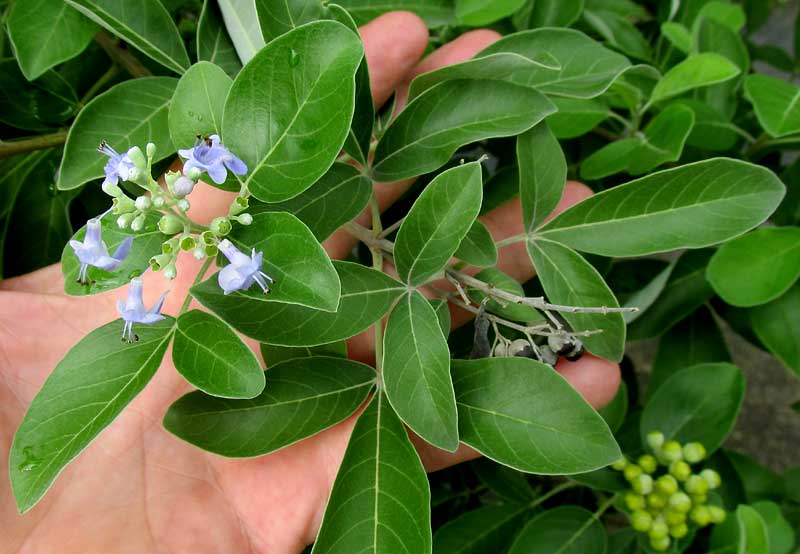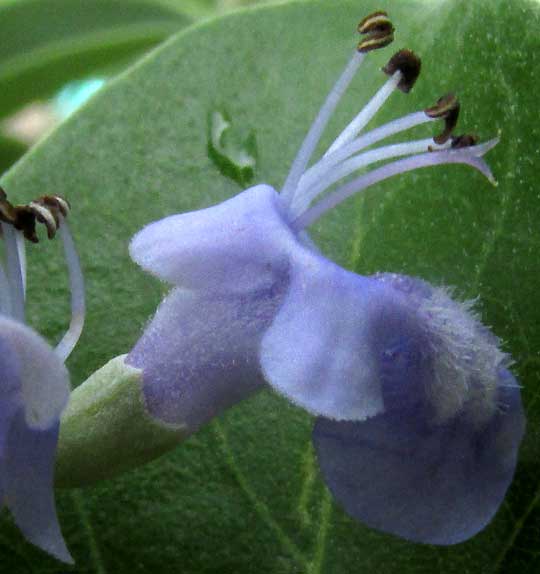Excerpts from Jim Conrad's
Naturalist Newsletter

from the October 25, 2015 Newsletter issued from Hacienda Chichen Resort beside Chichén Itzá Ruins, central Yucatán, MÉXICO
THREELEAF CHASTETREE
After getting a new six-month visa for Mexico by visiting Belize and walking across a bridge back into Mexico, last Tuesday morning I was in a weedy park in front of the ADO bus station in Chetumal, killing time until my 11PM bus left. Among the park's ornamental plantings was a dense, much-branched shrub about ten feet tall (3m) bearing panicles of pale blue flowers, as shown above.
Mostly the bush's leaves were compound, divided into three leaflets, but some consisted of only one blade, and a few had two leaflets. Leaves arose two per stem node, opposite one another, and the flowers up close were "irregular," showing bilateral and not radial symmetry, each blossom with four stamens and a forked style, as shown below:

Notice how these flowers nicely accommodate their pollinators by having their lower lips enlarged into a landing pad with downy hairs arising in the landing zone for the pollinators to hang on to. It's not all floristic altruism, though, for you can see how the style reaches out with its Y-shaped stigmas to receive pollen arriving on any pollinator's body. The bushes also bore clusters of drupe-type fruits, each containing four seeds, shown below:

The opposite leaves with divisions held like fingers on a hand (digitately compound), bilaterally symmetrical flower structure and those blackish fruits subtended by large, papery calyxes covering most of the fruits' bottom halves are all good field marks for the Vervain or Verbena Family, the Verbenaceae. And recently we've seen species with very similar features: In Texas we saw the Hemptree, profiled at www.backyardnature.net/n/w/vitex.htm.
And here in the Yucatan we have a wild tree sometimes called the Fiddlewood, displaying its similar flowers at www.backyardnature.net/yucatan/vitex.htm.
Both of these species belong to the genus Vitex, so it was easy to figure out that here we had VITEX TRIFOLIA, sometimes called the Threeleaf Chastetree. The "chaste" part of the name arises from the story told on the page for our Texas Hemptree, about that plant traditionally being considered an anaphrodisiac, which is the opposite of being an aphrodisiac.
Our Chetumal park Vitex wasn't known to be anaphrodisiacal, but in the part of the world where it naturally occurs -- southeastern Asia, Australia, Madagascar and thereabouts -- its dried leaves are known to repel mosquitoes when burned, and oils from its leaves are thought to offer a potential as a botanical pesticide. Various cultures use the plant medicinally, leaf poultices being employed to treat rheumatism, swollen testicles and such. In Malaysia teas from the fruits are used against intestinal worms, while in Vietnam the same teas are thought to cure common colds, headaches and watery eyes. The list of uses goes on and on. Compounds in the plant must be powerful ones because gardeners who prune the plants sometimes suffer from sneezing, coughing, dizziness, headaches, and nausea.
In this part of the world, however, these effects aren't known, since the plant isn't native. Apparently it was planted in this little park in Chetumal just because it's a pretty tree that seems to keep its flowers for a long time.